Sunway University MGT 3073: Leadership Orientation Report Analysis
VerifiedAdded on 2022/08/14
|5
|1547
|22
Report
AI Summary
This report presents an analysis of leadership orientation, fulfilling the requirements of a Sunway University MGT 3073 assignment. The analysis is structured around the four-frame model, incorporating assessments of servant leadership, Machiavellian leadership, and the Big Five personality traits. The findings are discussed in relation to the author's leadership orientation, using a matrix table to illustrate the connections between these different frameworks. The report also explores the implications of these findings for leadership development, focusing specifically on the area of conscientiousness within the structural frame. The report utilizes various academic sources to support its arguments and conclusions.
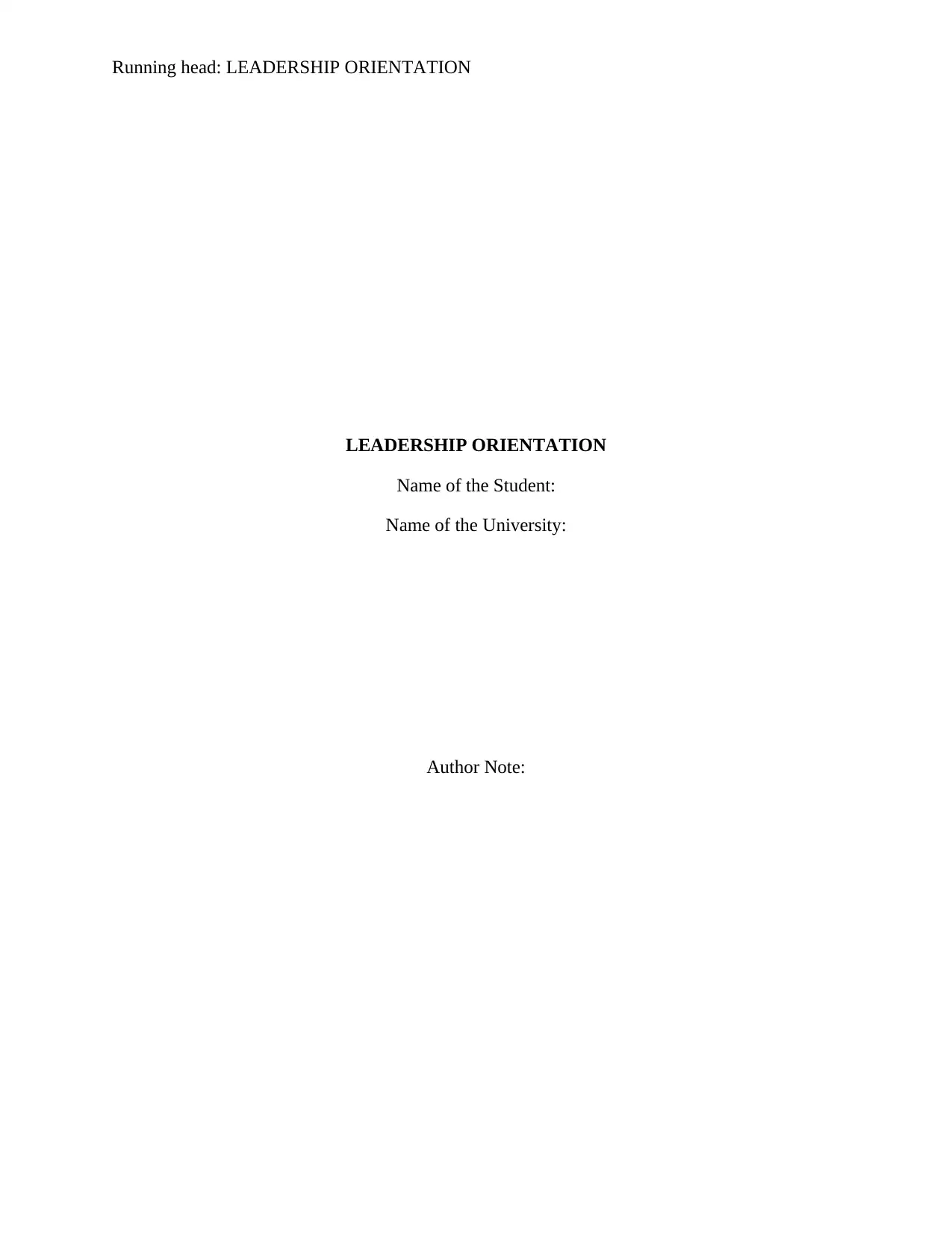
Running head: LEADERSHIP ORIENTATION
LEADERSHIP ORIENTATION
Name of the Student:
Name of the University:
Author Note:
LEADERSHIP ORIENTATION
Name of the Student:
Name of the University:
Author Note:
Paraphrase This Document
Need a fresh take? Get an instant paraphrase of this document with our AI Paraphraser
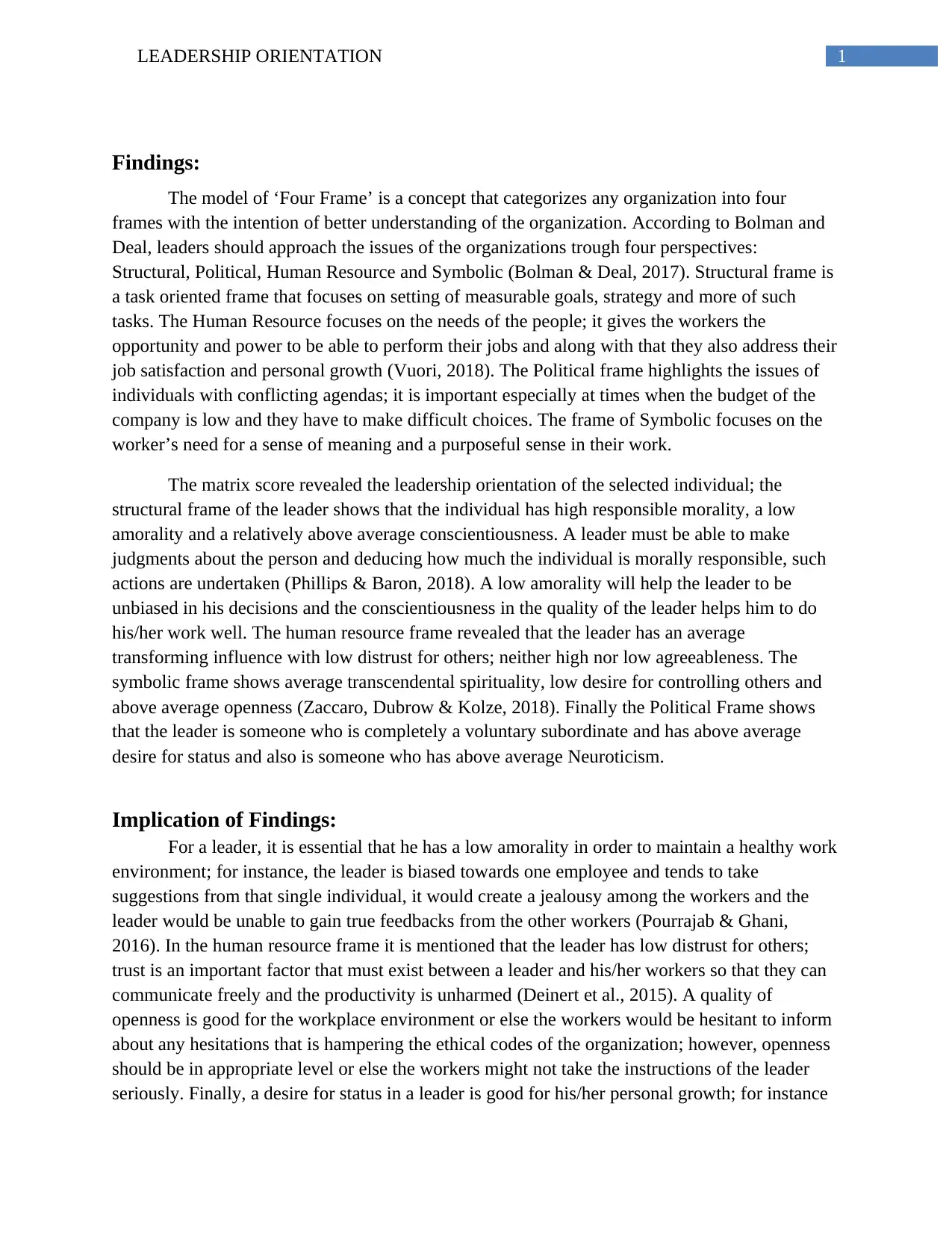
1LEADERSHIP ORIENTATION
Findings:
The model of ‘Four Frame’ is a concept that categorizes any organization into four
frames with the intention of better understanding of the organization. According to Bolman and
Deal, leaders should approach the issues of the organizations trough four perspectives:
Structural, Political, Human Resource and Symbolic (Bolman & Deal, 2017). Structural frame is
a task oriented frame that focuses on setting of measurable goals, strategy and more of such
tasks. The Human Resource focuses on the needs of the people; it gives the workers the
opportunity and power to be able to perform their jobs and along with that they also address their
job satisfaction and personal growth (Vuori, 2018). The Political frame highlights the issues of
individuals with conflicting agendas; it is important especially at times when the budget of the
company is low and they have to make difficult choices. The frame of Symbolic focuses on the
worker’s need for a sense of meaning and a purposeful sense in their work.
The matrix score revealed the leadership orientation of the selected individual; the
structural frame of the leader shows that the individual has high responsible morality, a low
amorality and a relatively above average conscientiousness. A leader must be able to make
judgments about the person and deducing how much the individual is morally responsible, such
actions are undertaken (Phillips & Baron, 2018). A low amorality will help the leader to be
unbiased in his decisions and the conscientiousness in the quality of the leader helps him to do
his/her work well. The human resource frame revealed that the leader has an average
transforming influence with low distrust for others; neither high nor low agreeableness. The
symbolic frame shows average transcendental spirituality, low desire for controlling others and
above average openness (Zaccaro, Dubrow & Kolze, 2018). Finally the Political Frame shows
that the leader is someone who is completely a voluntary subordinate and has above average
desire for status and also is someone who has above average Neuroticism.
Implication of Findings:
For a leader, it is essential that he has a low amorality in order to maintain a healthy work
environment; for instance, the leader is biased towards one employee and tends to take
suggestions from that single individual, it would create a jealousy among the workers and the
leader would be unable to gain true feedbacks from the other workers (Pourrajab & Ghani,
2016). In the human resource frame it is mentioned that the leader has low distrust for others;
trust is an important factor that must exist between a leader and his/her workers so that they can
communicate freely and the productivity is unharmed (Deinert et al., 2015). A quality of
openness is good for the workplace environment or else the workers would be hesitant to inform
about any hesitations that is hampering the ethical codes of the organization; however, openness
should be in appropriate level or else the workers might not take the instructions of the leader
seriously. Finally, a desire for status in a leader is good for his/her personal growth; for instance
Findings:
The model of ‘Four Frame’ is a concept that categorizes any organization into four
frames with the intention of better understanding of the organization. According to Bolman and
Deal, leaders should approach the issues of the organizations trough four perspectives:
Structural, Political, Human Resource and Symbolic (Bolman & Deal, 2017). Structural frame is
a task oriented frame that focuses on setting of measurable goals, strategy and more of such
tasks. The Human Resource focuses on the needs of the people; it gives the workers the
opportunity and power to be able to perform their jobs and along with that they also address their
job satisfaction and personal growth (Vuori, 2018). The Political frame highlights the issues of
individuals with conflicting agendas; it is important especially at times when the budget of the
company is low and they have to make difficult choices. The frame of Symbolic focuses on the
worker’s need for a sense of meaning and a purposeful sense in their work.
The matrix score revealed the leadership orientation of the selected individual; the
structural frame of the leader shows that the individual has high responsible morality, a low
amorality and a relatively above average conscientiousness. A leader must be able to make
judgments about the person and deducing how much the individual is morally responsible, such
actions are undertaken (Phillips & Baron, 2018). A low amorality will help the leader to be
unbiased in his decisions and the conscientiousness in the quality of the leader helps him to do
his/her work well. The human resource frame revealed that the leader has an average
transforming influence with low distrust for others; neither high nor low agreeableness. The
symbolic frame shows average transcendental spirituality, low desire for controlling others and
above average openness (Zaccaro, Dubrow & Kolze, 2018). Finally the Political Frame shows
that the leader is someone who is completely a voluntary subordinate and has above average
desire for status and also is someone who has above average Neuroticism.
Implication of Findings:
For a leader, it is essential that he has a low amorality in order to maintain a healthy work
environment; for instance, the leader is biased towards one employee and tends to take
suggestions from that single individual, it would create a jealousy among the workers and the
leader would be unable to gain true feedbacks from the other workers (Pourrajab & Ghani,
2016). In the human resource frame it is mentioned that the leader has low distrust for others;
trust is an important factor that must exist between a leader and his/her workers so that they can
communicate freely and the productivity is unharmed (Deinert et al., 2015). A quality of
openness is good for the workplace environment or else the workers would be hesitant to inform
about any hesitations that is hampering the ethical codes of the organization; however, openness
should be in appropriate level or else the workers might not take the instructions of the leader
seriously. Finally, a desire for status in a leader is good for his/her personal growth; for instance
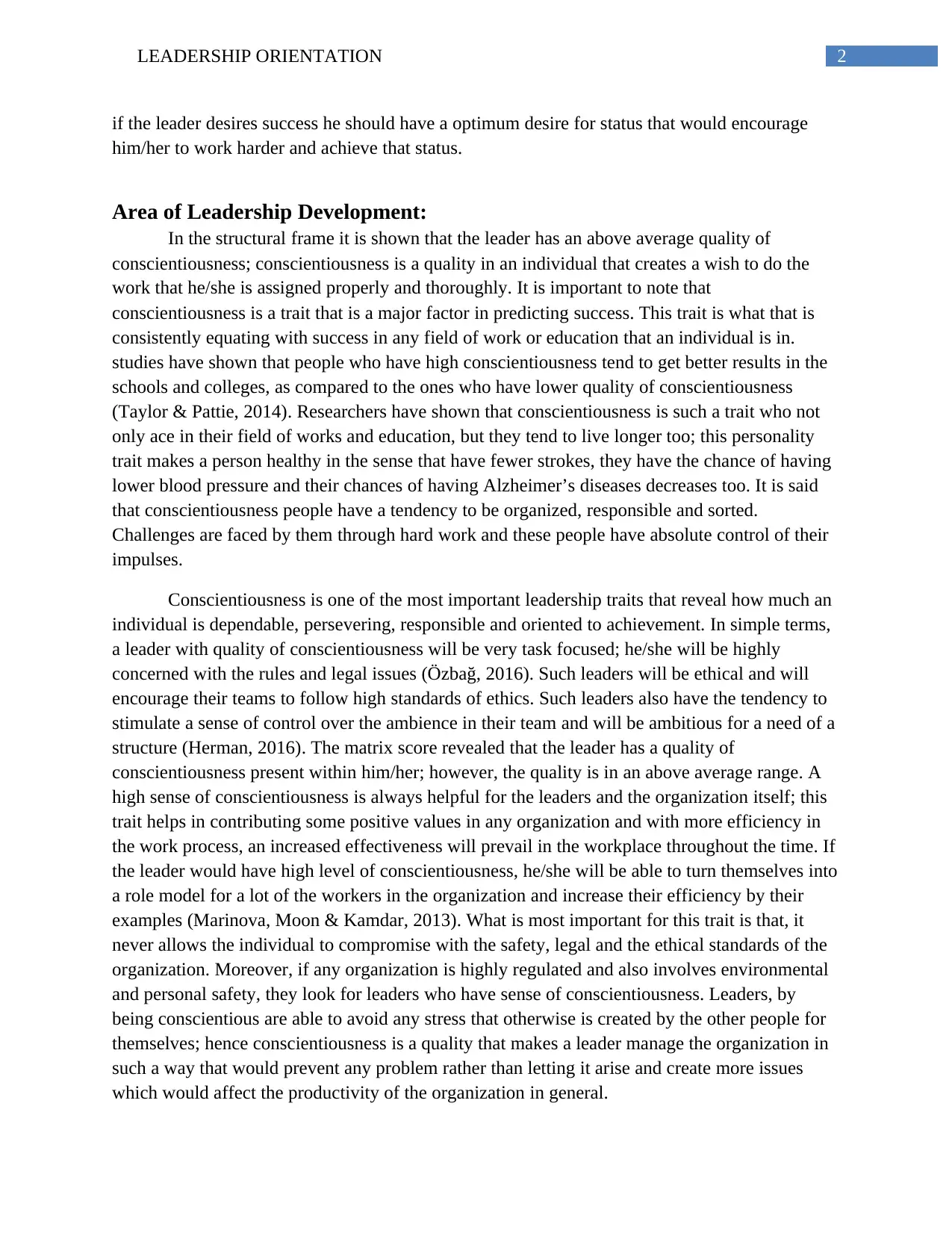
2LEADERSHIP ORIENTATION
if the leader desires success he should have a optimum desire for status that would encourage
him/her to work harder and achieve that status.
Area of Leadership Development:
In the structural frame it is shown that the leader has an above average quality of
conscientiousness; conscientiousness is a quality in an individual that creates a wish to do the
work that he/she is assigned properly and thoroughly. It is important to note that
conscientiousness is a trait that is a major factor in predicting success. This trait is what that is
consistently equating with success in any field of work or education that an individual is in.
studies have shown that people who have high conscientiousness tend to get better results in the
schools and colleges, as compared to the ones who have lower quality of conscientiousness
(Taylor & Pattie, 2014). Researchers have shown that conscientiousness is such a trait who not
only ace in their field of works and education, but they tend to live longer too; this personality
trait makes a person healthy in the sense that have fewer strokes, they have the chance of having
lower blood pressure and their chances of having Alzheimer’s diseases decreases too. It is said
that conscientiousness people have a tendency to be organized, responsible and sorted.
Challenges are faced by them through hard work and these people have absolute control of their
impulses.
Conscientiousness is one of the most important leadership traits that reveal how much an
individual is dependable, persevering, responsible and oriented to achievement. In simple terms,
a leader with quality of conscientiousness will be very task focused; he/she will be highly
concerned with the rules and legal issues (Özbağ, 2016). Such leaders will be ethical and will
encourage their teams to follow high standards of ethics. Such leaders also have the tendency to
stimulate a sense of control over the ambience in their team and will be ambitious for a need of a
structure (Herman, 2016). The matrix score revealed that the leader has a quality of
conscientiousness present within him/her; however, the quality is in an above average range. A
high sense of conscientiousness is always helpful for the leaders and the organization itself; this
trait helps in contributing some positive values in any organization and with more efficiency in
the work process, an increased effectiveness will prevail in the workplace throughout the time. If
the leader would have high level of conscientiousness, he/she will be able to turn themselves into
a role model for a lot of the workers in the organization and increase their efficiency by their
examples (Marinova, Moon & Kamdar, 2013). What is most important for this trait is that, it
never allows the individual to compromise with the safety, legal and the ethical standards of the
organization. Moreover, if any organization is highly regulated and also involves environmental
and personal safety, they look for leaders who have sense of conscientiousness. Leaders, by
being conscientious are able to avoid any stress that otherwise is created by the other people for
themselves; hence conscientiousness is a quality that makes a leader manage the organization in
such a way that would prevent any problem rather than letting it arise and create more issues
which would affect the productivity of the organization in general.
if the leader desires success he should have a optimum desire for status that would encourage
him/her to work harder and achieve that status.
Area of Leadership Development:
In the structural frame it is shown that the leader has an above average quality of
conscientiousness; conscientiousness is a quality in an individual that creates a wish to do the
work that he/she is assigned properly and thoroughly. It is important to note that
conscientiousness is a trait that is a major factor in predicting success. This trait is what that is
consistently equating with success in any field of work or education that an individual is in.
studies have shown that people who have high conscientiousness tend to get better results in the
schools and colleges, as compared to the ones who have lower quality of conscientiousness
(Taylor & Pattie, 2014). Researchers have shown that conscientiousness is such a trait who not
only ace in their field of works and education, but they tend to live longer too; this personality
trait makes a person healthy in the sense that have fewer strokes, they have the chance of having
lower blood pressure and their chances of having Alzheimer’s diseases decreases too. It is said
that conscientiousness people have a tendency to be organized, responsible and sorted.
Challenges are faced by them through hard work and these people have absolute control of their
impulses.
Conscientiousness is one of the most important leadership traits that reveal how much an
individual is dependable, persevering, responsible and oriented to achievement. In simple terms,
a leader with quality of conscientiousness will be very task focused; he/she will be highly
concerned with the rules and legal issues (Özbağ, 2016). Such leaders will be ethical and will
encourage their teams to follow high standards of ethics. Such leaders also have the tendency to
stimulate a sense of control over the ambience in their team and will be ambitious for a need of a
structure (Herman, 2016). The matrix score revealed that the leader has a quality of
conscientiousness present within him/her; however, the quality is in an above average range. A
high sense of conscientiousness is always helpful for the leaders and the organization itself; this
trait helps in contributing some positive values in any organization and with more efficiency in
the work process, an increased effectiveness will prevail in the workplace throughout the time. If
the leader would have high level of conscientiousness, he/she will be able to turn themselves into
a role model for a lot of the workers in the organization and increase their efficiency by their
examples (Marinova, Moon & Kamdar, 2013). What is most important for this trait is that, it
never allows the individual to compromise with the safety, legal and the ethical standards of the
organization. Moreover, if any organization is highly regulated and also involves environmental
and personal safety, they look for leaders who have sense of conscientiousness. Leaders, by
being conscientious are able to avoid any stress that otherwise is created by the other people for
themselves; hence conscientiousness is a quality that makes a leader manage the organization in
such a way that would prevent any problem rather than letting it arise and create more issues
which would affect the productivity of the organization in general.
⊘ This is a preview!⊘
Do you want full access?
Subscribe today to unlock all pages.

Trusted by 1+ million students worldwide
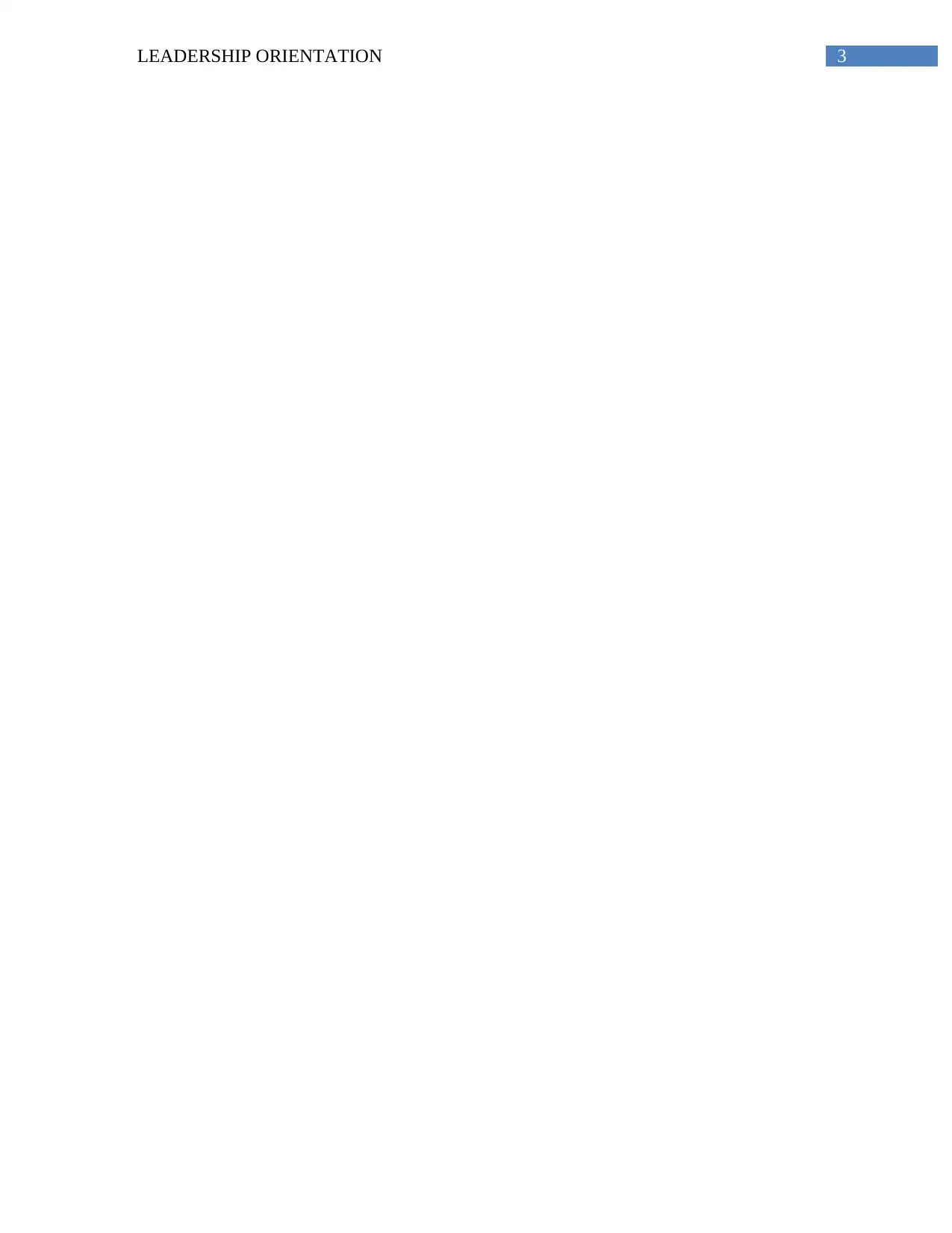
3LEADERSHIP ORIENTATION
Paraphrase This Document
Need a fresh take? Get an instant paraphrase of this document with our AI Paraphraser
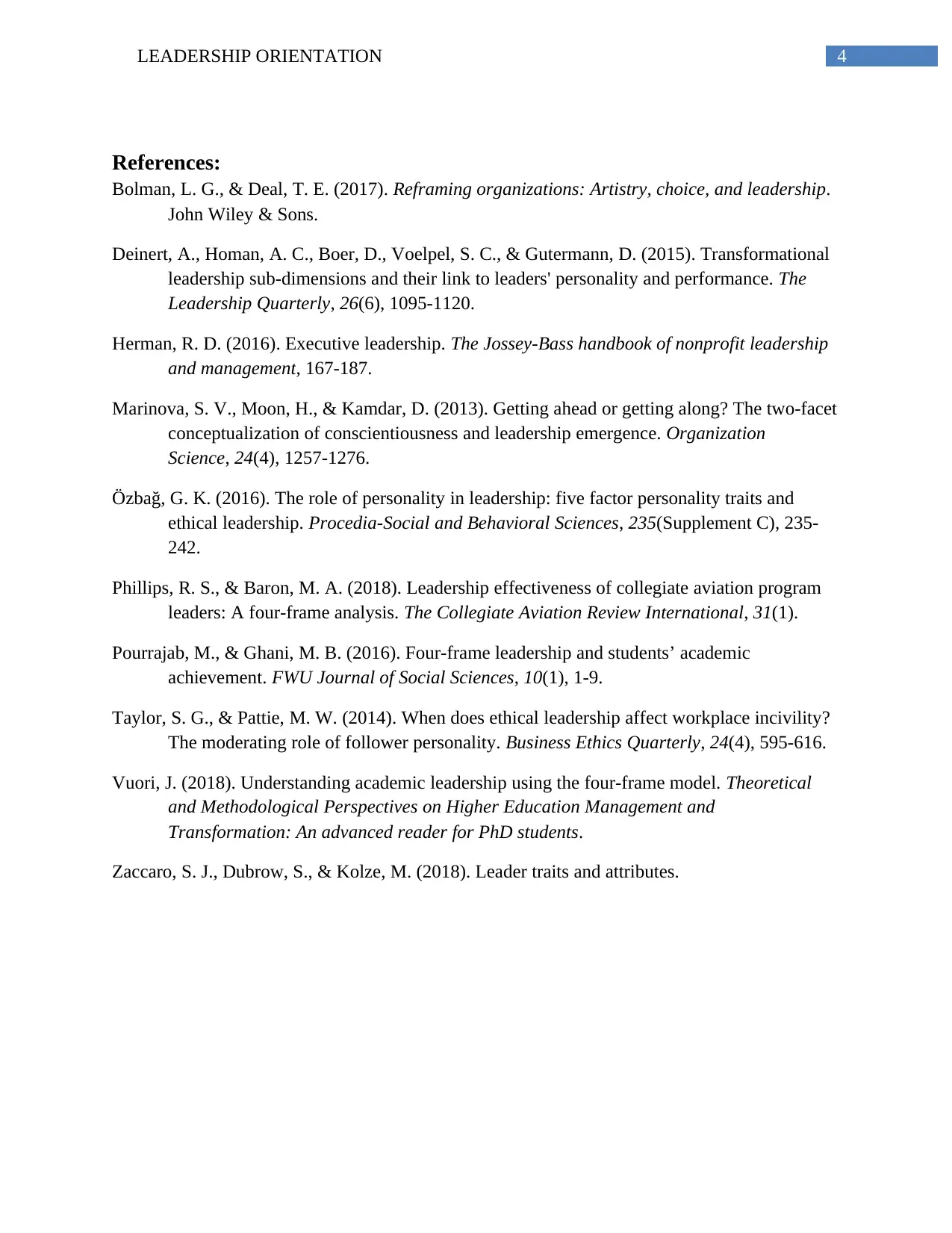
4LEADERSHIP ORIENTATION
References:
Bolman, L. G., & Deal, T. E. (2017). Reframing organizations: Artistry, choice, and leadership.
John Wiley & Sons.
Deinert, A., Homan, A. C., Boer, D., Voelpel, S. C., & Gutermann, D. (2015). Transformational
leadership sub-dimensions and their link to leaders' personality and performance. The
Leadership Quarterly, 26(6), 1095-1120.
Herman, R. D. (2016). Executive leadership. The Jossey-Bass handbook of nonprofit leadership
and management, 167-187.
Marinova, S. V., Moon, H., & Kamdar, D. (2013). Getting ahead or getting along? The two-facet
conceptualization of conscientiousness and leadership emergence. Organization
Science, 24(4), 1257-1276.
Özbağ, G. K. (2016). The role of personality in leadership: five factor personality traits and
ethical leadership. Procedia-Social and Behavioral Sciences, 235(Supplement C), 235-
242.
Phillips, R. S., & Baron, M. A. (2018). Leadership effectiveness of collegiate aviation program
leaders: A four-frame analysis. The Collegiate Aviation Review International, 31(1).
Pourrajab, M., & Ghani, M. B. (2016). Four-frame leadership and students’ academic
achievement. FWU Journal of Social Sciences, 10(1), 1-9.
Taylor, S. G., & Pattie, M. W. (2014). When does ethical leadership affect workplace incivility?
The moderating role of follower personality. Business Ethics Quarterly, 24(4), 595-616.
Vuori, J. (2018). Understanding academic leadership using the four-frame model. Theoretical
and Methodological Perspectives on Higher Education Management and
Transformation: An advanced reader for PhD students.
Zaccaro, S. J., Dubrow, S., & Kolze, M. (2018). Leader traits and attributes.
References:
Bolman, L. G., & Deal, T. E. (2017). Reframing organizations: Artistry, choice, and leadership.
John Wiley & Sons.
Deinert, A., Homan, A. C., Boer, D., Voelpel, S. C., & Gutermann, D. (2015). Transformational
leadership sub-dimensions and their link to leaders' personality and performance. The
Leadership Quarterly, 26(6), 1095-1120.
Herman, R. D. (2016). Executive leadership. The Jossey-Bass handbook of nonprofit leadership
and management, 167-187.
Marinova, S. V., Moon, H., & Kamdar, D. (2013). Getting ahead or getting along? The two-facet
conceptualization of conscientiousness and leadership emergence. Organization
Science, 24(4), 1257-1276.
Özbağ, G. K. (2016). The role of personality in leadership: five factor personality traits and
ethical leadership. Procedia-Social and Behavioral Sciences, 235(Supplement C), 235-
242.
Phillips, R. S., & Baron, M. A. (2018). Leadership effectiveness of collegiate aviation program
leaders: A four-frame analysis. The Collegiate Aviation Review International, 31(1).
Pourrajab, M., & Ghani, M. B. (2016). Four-frame leadership and students’ academic
achievement. FWU Journal of Social Sciences, 10(1), 1-9.
Taylor, S. G., & Pattie, M. W. (2014). When does ethical leadership affect workplace incivility?
The moderating role of follower personality. Business Ethics Quarterly, 24(4), 595-616.
Vuori, J. (2018). Understanding academic leadership using the four-frame model. Theoretical
and Methodological Perspectives on Higher Education Management and
Transformation: An advanced reader for PhD students.
Zaccaro, S. J., Dubrow, S., & Kolze, M. (2018). Leader traits and attributes.
1 out of 5
Your All-in-One AI-Powered Toolkit for Academic Success.
+13062052269
info@desklib.com
Available 24*7 on WhatsApp / Email
![[object Object]](/_next/static/media/star-bottom.7253800d.svg)
Unlock your academic potential
Copyright © 2020–2025 A2Z Services. All Rights Reserved. Developed and managed by ZUCOL.

![Leadership Qualities Self Analysis Report - [University Name]](/_next/image/?url=https%3A%2F%2Fdesklib.com%2Fmedia%2Fimages%2Fgz%2F18fd87affd6949e69fb1fcec05fa0d86.jpg&w=256&q=75)
